

|
|
Study, work or travel in the UK. British
culture and life.
|
|
||
|
|
|
|
||
 |
||||
|
|
|
|
||
 |
||||
|
The adventures of a disabled woman on holiday in London
|
||||
|
Sections:
|
Introduction |
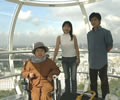 |
| Preparations | ||
| Sunday 15 September | ||
| Monday 16 September | ||
| Tuesday 17 September | ||
| Wednesday 18 September | ||
| Thursday 19 September | ||
| Friday 20 September | ||
| Saturday 21 September | ||
| Links |
| Preparations |
- Flight
If possible, book the flight a couple of months before you wish to travel. This
is because it may be easier to get cheaper tickets and some time may be needed
if special arrangements have to be made by the airline or airports. Kaori had
to book the flight only a couple of weeks before travelling, and found that
it was a busy time (because there are two public holidays at this time of year
in Japan). She needed to contact several airlines to ask them about their policies
for disabled passengers. She decided to fly by Virgin Airlines from Tokyo Narita
to London Heathrow. Akemi and her daughter both needed to buy first class tickets
- this was by far the biggest expense of the trip. If you are being met by someone
at Heathrow airport, check which terminal you will arrive at. Heathrow is a
very large airport and currently has four terminals.
- Accommodation
When booking accommodation, be careful about the dates. Kaori assumed that her
flight from Japan to the UK would be arriving on the next day, but in fact it
arrived on the same day (because of the time difference). Luckily this problem
was noticed before arrival and an extra night at the hotel was booked.
Booked rooms at the Copthorne Tara, Scarsdale Place, Kensington, London W8 5SR
(020 7937 7211): http://www.mill-cop.com.
Booked using HolidayCare: http://www.holidaycare.org.uk.
Had to pay a joining fee of £35, but then could book rooms at cheap rates
at the hotel. They also helped to arrange the rental of a special mattress,
although this could not be delivered on Sunday so could not be available for
the first night.
- Entertainment
| Sunday 15 September 2002 |
- Airport
Transferred at the departure gate at Narita to a special narrow wheelchair to
get to the aircraft seat.
11am (Japanese time; 3am UK time)- plane leaves Narita.
Akemi and her helper (her daughter Kaori) travelled first class. The seat could
be made flat and it was possible to get some sleep. It was possible to use the
toilet on the plane, using the aircraft wheelchair to get there.
3.10pm (12 hours after takeoff) - plane lands at Terminal 3 Heathrow, about
50 minutes early.
The wheelchair needed a special security check, because the frame would have
set off a metal detector and needs to be checked for drugs or explosives.
Akemi's comments:
Akemi had been a bit worried about travelling by air. The journey from Japan
is long (12 hours), so being able to use the toilet was important. She was worried
about turbulence, which could have affected her weak neck, but the journey was
smooth. Having to buy first class tickets for both herself and Kaori was very
expensive, but all the airlines contacted seemed to have the same policy.
- Taxis
Although the airline's first class tickets included the possibility of a free
limousine from the airport to the hotel, this had not been requested and would
not have been a wheelchair-accessible vehicle. To find the taxi, was requested
to go to the Taxi Information Desk. The taxi meter started from the time the
taxi was requested plus an allowed waiting time of 10 minutes. We left the airport
terminal at 4.10pm and arrived at the hotel at 5.00pm. The taxi journey cost
about £50 (charged directly to the credit card), including a booking fee
and service charge. It is cheaper to get a taxi directly from the taxi rank
at the airport, although this might require some waiting (do not accept offers
from drivers who come up to you asking if you want a taxi).
All London black cabs are supposed to be accessible for wheelchairs. There is
space for a wheelchair on the left-hand side. Most taxis are licensed to carry
5 people, but there is only room for 4 people including one person in a wheelchair.
The easiest thing for us was to put Akemi's wheelchair in sideways, which also
gave her a good view through the side window, although the chair is supposed
to face backwards so that the safety belt can be worn. The other three of us
sat on the back seat. Older models of taxi (Fairway) have two metal ramps in
the boot: these can be extended by pressing a catch (they can be noisy to open);
we put the ramps under the chair during the journey so that they could be taken
out quickly at the end of the journey. The ramps must be made parallel and should
be put well apart so that the wheels don't catch when going up. Newer models
of taxi (TX1) have a short ramp built into the floor on the left-hand side.
It is useful to carry a 50-pence coin which can be used to release the screw
so that this ramp can be pulled out (an extension to this ramp is carried in
the boot: this is needed if you need to get down to road level instead of to
pavement level).
Over the following week we used taxis about 20 times. About a third of black
cabs refused to carry us, mainly because we requested a ramp. Some of the excuses
given were that their ramp wasn't working, that the ramp couldn't be got out
of the boot (in one case because the driver's golf clubs were there!) or that
the ramp didn't fit the taxi because it "wasn't their cab" or because
it had been serviced recently and had been equipped with the wrong one. Some
drivers suggested lifting the wheelchair in and out instead of using the ramp,
but this wasn't practical because Akemi's neck is sensitive, and the chair is
heavy. If you have trouble getting a cab to accept you, ask the driver for their
number (or copy it from the back of the cab) and report it to the Public Carriage
Office: http://www.london-taxi.co.uk/taxi/complaints.htm
(this will help other disabled passengers to have a better experience in future).
One third of the drivers we asked accepted us but made it very obvious that
they were unhappy to be asked to use their ramps. The other third of drivers
accepted us without complaining and were polite and friendly (of course we gave
bigger tips to these drivers). We soon found that we were more experienced than
the drivers about using the ramps and needed to show them what to do.
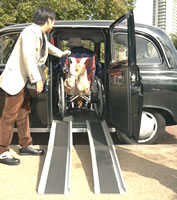 'Fairway' taxi ramps |
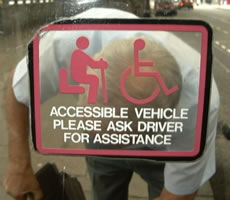 Assistance from a taxi driver |
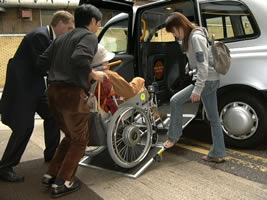 'TX1' taxi ramps, with extension |
The hotel room was on the Mezzanine floor (M), which is half way between the
Ground floor (G) and the first floor (1). The way of numbering the floors is
different from in Japan, where the ground floor is known as the first floor.
There were no steps, which made it easy to get around the hotel. Doors could
be opened automatically by pressing a button on the side. The door to the room
also opened automatically when the key was entered, and could also be opened
by pressing a button next to the bed or near the door. The bed was normal, but
equipment to allow Akemi to sit up by herself was rented (unfortunately it could
not be delivered on a Sunday). There was a TV, including a Japanese channel.
The bathroom had a wide door and included a low toilet and wash basin and accessible
shower, plus handrails. There were twin beds in the room (one for Akemi and
one for her daughter Kaori). There was a connecting door inside the room to
another ordinary twin room, where Mark and Yukihito slept.
That evening we ate in the hotel's restaurant. When the bill arrived, Kaori
wasn't sure if the service charge was included. It stated "gratuities are
at your discretion". Mark explained that this meant that a service charge
was not included and that a 10% tip might be appropriate.
Yukihito asked if the hotel's water was drinkable. Mark explained that it is
usually fine to drink water from the cold tap in hotels in the UK, but that
the water is often hard (this means that it contains minerals and may create
a thin layer on top of a cup of tea). Yukihito went out to buy bottled water.
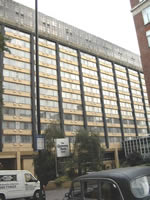 Copthorne Tara hotel |
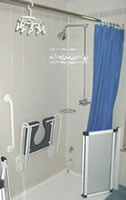 Shower |
 Basin and toilet |
| Monday 16 September 2002 |
- Hyde Park
11.00 Taxi from the hotel to Hyde Park. We asked the taxi to drop us off at
the east end of South Carriage Drive, not far from the statue of Achilles. Cost:
£9.
We passed through the Rose Garden. As well as the trees and flowers, it was
interesting to see the squirrels, and birds. We wandered west to the large lake
(the Serpentine). There is a cafe there - we could have had something to eat
and used the toilets, but decided not to stop. We followed the northern edge
of the Serpentine lake, and then crossed the Serpentine Bridge. There was a
level place for us to cross but no traffic lights, so we waited for drivers
to stop for us before we crossed. We walked past the Serpentine Gallery and
toilets and then followed the Flower Walk to the Albert Memorial (a large statue
built to remember Prince Albert, who was the husband of Queen Victoria). There
is a ramp on one side of the statue, so we could enjoy looking around it. From
the front there is a wonderful view of the Royal Albert Hall, where the Last
Night of the Proms (a famous classical concert) had taken place the previous
Saturday.
There is a free service called Liberty Drives run by volunteers (although it
is free, donations are welcomed to help the service to continue). This allows
a disabled person and people in the same group to be driven between certain
pick up points around Hyde Park on a small electric vehicle. Hyde Park is very
large, so this can be a convenient way for a disabled person to see it. The
service does not operate on Mondays, so we did not try this. For more details,
see: http://www.hydeparkappeal.org.
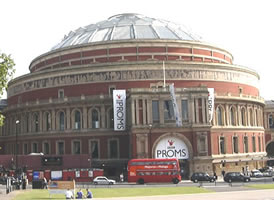 The Royal Albert Hall |
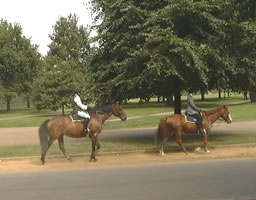 Horse riding in Hyde Park |
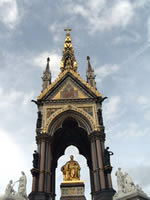 The Albert Memorial |
2.00 Taxi from in front of the Albert Memorial to Hans Road, off Brompton Road,
in front of Harrods. Cost: £8.
Harrods is a very large department store: http://www.harrods.com;
telephone: 020 7730 1234; opening times: 10 to 7pm, Monday to Saturday (usually
closed on Sunday). It is wheelchair accessible and was a convenient place to
do all types of shopping. We entered door 3 and obtained store guides from the
information desk, including one in Japanese. It would have been possible to
have reclaimed VAT (value added tax) on the souvenirs bought (as these were
worth more than £50), but this would have involved spending some time
after finishing shopping to go to the Tax Free Shopping Bureau on the Lower
Ground or Fourth Floor (taking our receipts from Harrods), and also would have
taken some time at the airport. We used the lifts opposite Door 3 to access
all floors. The route followed was:
Fourth Floor: Lift; Disabled toilets; Harrods World; Planet Harrods;
Georgian Restaurant; 3.00 - 5.00pm: Afternoon tea at the Georgian Restaurant
(reserved in advance). Afternoon teas are large, so it is better to avoid having
lunch before this or a big supper afterwards.
Lower Ground Floor: Lift; Men's Designer Collections; Egyptian Escalator;
Memorial to Princess Diana and Dodi Al Fayed; Harrods Shop; Lift
Ground Floor: Lift; Cosmetics; Cheeses; Fruit; Meat; Tea; Perfumery;
Harrods Arcade; Cosmetics; Lift
The shop closed at 7pm, and we took a taxi back to the hotel (cost: £9).
It took a bit of time to get a taxi, partly because many other shoppers left
at this time.
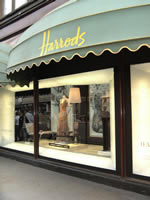 Harrods shop window |
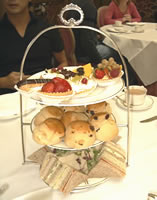 Afternoon tea |
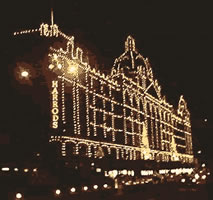 Harrods at night |
| Tuesday 17 September 2002 |
- London Eye
9.00 Taxi from the hotel to in front of the London Eye (Belvedere Road). It
was the rush hour, and there were roadworks, so the journey took longer than
expected. Cost: £20..
For information about the London Eye, see: http://www.ba-londoneye.com.
Normal tickets cost £10.50 each, but Akemi's ticket was £9 and one
carer was allowed to travel free (there was also a £1.50 booking fee).
There is a special telephone number to make bookings which include a disabled
person: 0870 990 8885.
There is a level path straight to the queue in front of the London Eye. A disabled
path on the left is for access to the ticket office and toilets, but we had
bought tickets in advance and didn't need to use this. Our tickets were marked
10am (for a ride starting between 10am and 10.30am), and we got on at about
10.10am. The wheel was stopped briefly to enable Akemi to get on safely. We
were given a pod just for our group of four. The London Eye gives beautiful
views of London, and the ride lasts about 30 minutes. It is worth buying one
of the guides before getting on, so that you can work out the location of some
of the famous places, such as Buckingham Palace, St Paul's Cathedral and Tower
Bridge. About 5 minutes before the end of the journey, there is an announcement
that a photo will be taken automatically. You can see the cameras on both sides,
and you should stand in view of these if you want to buy a souvenir photo at
the exit. We got off the wheel at 10.40am. Mark introduced his parents, who
had travelled to London by train to Waterloo station.
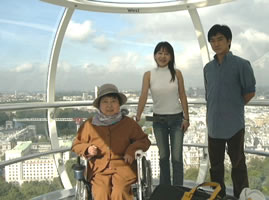 Inside a pod of the London Eye |
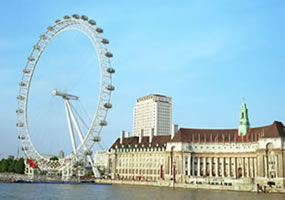 The London Eye and County Hall |
Akemi's comments:
Akemi enjoyed the views from the London Eye: it was a lovely way to see London.
She was surprised that she would be able to get onto the wheel.
- Boat cruise
There is a circular cruise on the river from the London Eye to Tower Bridge
and back, but we wanted to travel further on the river and go to Greenwich by
boat.
We used a boat trip run by City Cruises: http://www.citycruises.com/riverred.htm.
We bought River Red Rover day tickets, which allow unlimited use of their boat
services during the day. The full price was £8, but Mark could get a third
off by showing his travel pass, and people over 60 can also travel cheaply.
The entrance to Waterloo Pier is on the right-hand side of the London Eye. Boats
to Greenwich Pier leave every 40 minutes in September. We left Waterloo Pier
at 10.50, arrived at Tower Pier at 11.20, stayed on the boat which left Tower
Pier at 11.30 and arrived at Greenwich Pier at 12.00.
Care is required when getting onto the boat, but staff will help with this.
To get into the lower deck it is necessary to go over a metal barrier which
is about 5 centimetres high (this was not a problem for Akemi with Yukihito's
help). Akemi stayed in a flat area at the front of the boat's lower deck, from
which there were clear views. Kaori and Yukihito went to the upper deck for
some of the journey (the upper deck is outside, but can only be reached by steps
so it is not accessible for a wheelchair). There is a commentary, but this is
not easy to understand for someone who is not a fluent English speaker. Hot
and cold drinks are available on the boat: although the tables and seats are
fixed, there was enough room for Akemi to sit at the end of one of the tables.
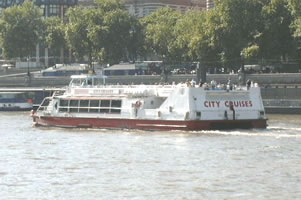 City Cruises river boat |
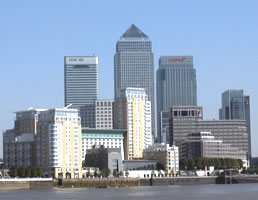 Canary Wharf (Docklands) |
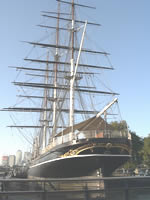 The Cutty Sark |
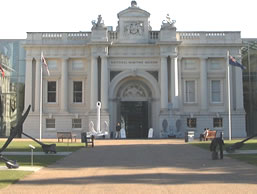 The National Maritime Museum |
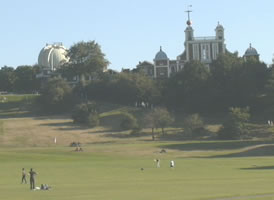 Royal Observatory, Greenwich Park |
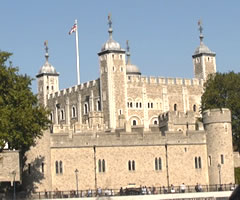 The Tower of London |
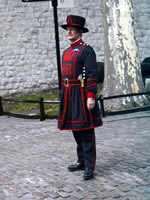 Yeoman of the guard |
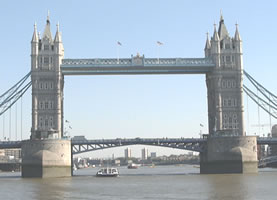 Tower Bridge |
| Wednesday 18 September 2002 |
- St James's Park
9.00 Taxi to the Marlborough Gate entrance of St James's Park (on the south
side of The Mall, opposite Marlborough Road). Cost: £11.
There are toilets on the right-hand side of the gate. The disabled toilets are
sometimes made to look as if they are locked, to stop other people from using
them.
We walked around St James's Park, following the path. We took a little bit of
bread and some monkey nuts to feed the birds or squirrels. After crossing the
bridge over the lake, we turned right towards Buckingham Palace. We could see
the guards getting ready in Wellington Barracks. We crossed Spur Road and the
road in front of Buckingham Palace.
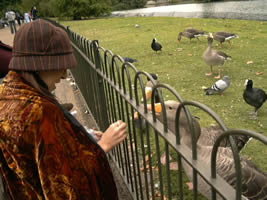 Meeting the ducks, St James's Park |
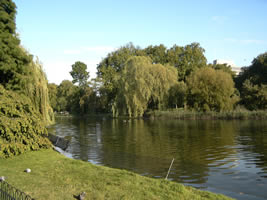 The lake in St James's Park |
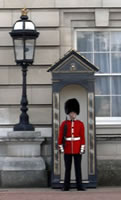 Guard box |
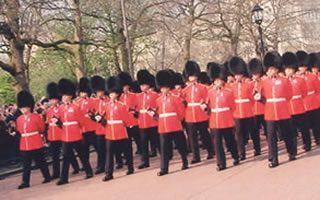 Changing of the Guard |
Mark had previously ordered tickets to see the Queen's Gallery and the State
Rooms at Buckingham Palace, by telephoning 020 7321 2233 (tickets can also be
bought by queuing at the kiosk on the south side of Green Park). For more details,
see the official website of the Queen: http://www.royal.gov.uk.
The palace is only open to the public in the summer, when the Queen is away
- in August and September. To enter these you are given a ticket with a time
at which you can enter: two separate tickets are required for the Queen's Gallery
and for the State Rooms. Mark had previously visited the Buckingham Palace Shop
at the north end of Buckingham Palace Road to buy the Japanese versions of the
guides to both parts of the palace so that Akemi could enjoy the visit more.
At 12.45 (the time on our ticket), we went to the entrance to the Queen's Gallery,
which is located on the south side of Buckingham Palace. There are special arrangements
for disabled visitors. If you have a large electric wheelchair you have to transfer
to a normal wheelchair provided by the Palace. Akemi's wheelchair is electric
but is not much bigger or heavier than a normal wheelchair, so she could stay
in her own chair during the visit. We were escorted to a special entrance where
we were given a security check and allowed to take a small lift up to the State
Rooms. It takes about 1 hour 30 minutes to look around the Queen's Gallery.
At 3pm (the time on our ticket) we returned to the gates in front of the Forecourt.
This is the entrance to the State Rooms for disabled visitors (other visitors
must join the queue on the south side of Buckingham Palace). We were escorted
inside the building. A chairlift allowed Akemi to go up to the top of some steps,
and then there was a lift up to the State Rooms. Disabled visitors follow a
different route from other people, so that they can avoid the stairs. While
we were looking around, an American lady came up to us who had seen us in front
of the palace that morning: she said that she had taken some photographs of
us during the Changing of the Guard and kindly offered to send them to us. It
took about 2 hours to visit the State Rooms and the shop.
Unfortunately we didn't have enough time during our visit to see the Royal Mews
(where they keep the Queen's carriages and horses) and the Guards' Museum (which
is next to Wellington Barracks, south of St James's Park). These are open at
other times of the year, so we could have visited them (and the Buckingham Palace
Shop) if we had come to London at a time when the palace was not open to visitors.
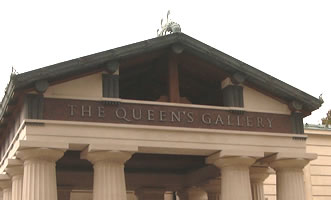 Entrance to the Queen's Gallery |
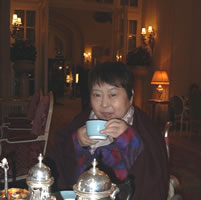 |
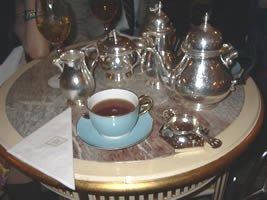 |
|
Taking tea at the Ritz
|
|
| Thursday 19 September 2002 |
Taxi to Great Russell Street main entrance of British Museum
- The British Museum
9.30am: We took a black cab from the hotel to the British Museum, arriving at
about 10.15am. Traffic in the rush hour was again very busy, so this cost £32.
We were dropped off on Great Russell Street, which is opposite the main entrance.
The British Museum contains beautiful treasures from many of the world's cultures.
For more details, see: http://www.thebritishmuseum.ac.uk.
Information about all of the exhibits is available online: http://www.thebritishmuseum.ac.uk/compass.
It is a very large museum, so if time is limited it is better to plan what you
want to see before you visit. The museum opens at 10am. It is free, but visitors
may make donations when they leave.
To enter the British Museum there is an automatic wheelchair lift on left-hand
side of the main stairs. The door to this special lift needs to be opened and
closed firmly. If necessary, there is a button that can be pressed to get help.
Inside the building there is an information desk, from which a map of the rooms
can be obtained. There are lifts and disabled toilets on both sides of Great
Court. We looked around the Egyptian, Greek, Roman, Korean and Japanese collections.
We forgot to look inside the Reading Room in the centre of Great Court. We ate
lunch in the restaurant on the second floor. This can be accessed by either
the West lift or the East lift, and has disabled toilets.
Akemi's comments:
We spent longer in the British Museum than we had planned, because there were
so many interesting things to see.
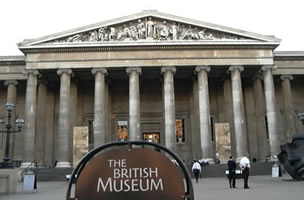 The British Museum |
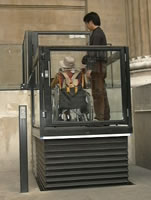 Chair lift entrance |
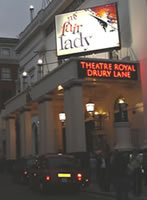 The Theatre Royal |
- My Fair Lady (Musical)
Mark had booked tickets for the musical My Fair Lady, which was on at the Theatre
Royal in Drury Lane. He booked by calling the Customer Relations Department,
020 7850 8530. There was a special section which deals with disabled bookings.
When booking by telephone, it is useful to see the seating plan for the theatre
(this is usually available on the theatre's website). We had seats K1-4. Tickets
cost £40 each, but one ticket was free. The musical is based on the book
Pygmalion by Bernard Shaw. The film version starring Audrey Hepburn (made in
the mid 1960s) is very famous.
We took a taxi to outside the disabled entrance for the Theatre Royal, which
is in the middle of Russell Street (opposite the Fortune Theatre). There were
many cars already parked in the area, so it wasn't possible for the taxi to
leave us directly opposite the entrance. At 7pm we entered the theatre by pressing
a bell and waiting for someone to let us in. The path to our seats (in the stalls,
which is the lower part of a theatre) was flat. The staff asked Akemi if she
wished to remain in her wheelchair for the show, and when she said she did they
removed her seat by unscrewing it from the floor. The musical started at 7.30pm
and ended at 10.45pm, with a 20 minute interval in the middle. We should have
booked a taxi to take us back to the hotel, because the area is very crowded
after the shows and there are not many available taxis there. Because there
were no taxis avaialble near the theatre, Mark walked down to the Strand to
get a black cab, which came to the theatre to pick up Akemi and her family.
| Friday 20 September 2002 |
- Kew Gardens
10.00 - We took a taxi from the hotel to the Main Gate at Kew Gardens (in the
road called Kew Green). Cost: £18.
For details of the Royal Botanic Gardens at Kew, see: http://www.rbgkew.org.uk
You can plan your visit using the map at: http://www.rbgkew.org.uk/visitor/KewMap.html.
There was an entrance charge of £6 each, but Akemi and one helper were
allowed in for free. There is a vehicle called the Kew Explorer which has space
for one wheelchair, and a vehicle called Discovery which can be booked in advance
for groups of disabled people. However, we preferred to concentrate on a small
part of the gardens and to travel by ourselves. We concentrated on the north
section, visiting various gardens and the Princess of Wales Conservatory before
ending up at the Victoria Gate Centre, where we ate a light lunch. There is
a shop and disabled toilets here. We left by Victoria Gate (on Kew Road, opposite
Lichfield Road). At 2.15pm we called a black cab to take us back to central
London.
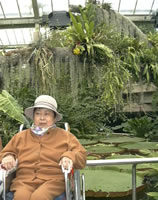 Conservatory |
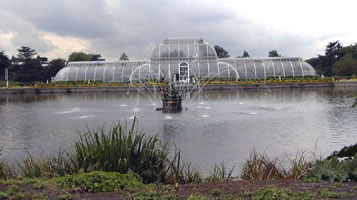 The Palm House, Kew Gardens |
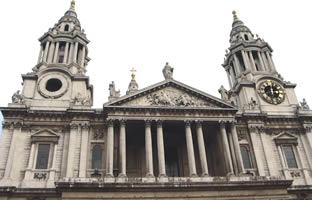 Front of St Paul's Cathedral |
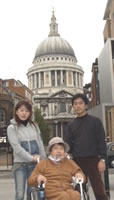 St Paul's Dome |
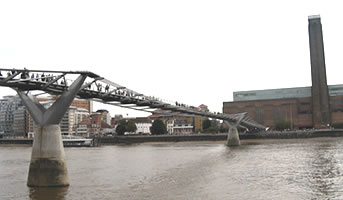 The Millennium Bridge |
| Saturday 21 September 2002 |
- Portobello Road
In the morning, Mark, Kaori and Yukihito left the hotel early (at 7am) to visit
Notting Hill, for the famous Portobello Road market. This would have been a
bit difficult for Akemi to visit (it is a busy street market), and she needed
to rest before the flight that afternoon. Neither Kaori not Yukihito had seen
the film "Notting Hill", but both wanted to feel the atmosphere of
the place before they watching the film in Japan. Saturday is the day of the
famous antique market (see: http://www.portobelloroad.co.uk),
which starts at 7am and becomes busy after 8am. We took the Tube from High Street
Kensington to Notting Hill Gate, arriving shortly before 7:30am. The Electric
Cinema which is close to the exit of Notting Hill Gate underground station is
shown in the film. We walked up Pembridge Road and turned left into Portobello
Road. The antiques market stalls are located at this end of the road, while
stalls for fruit and vegetables (as shown at the beginning of the film) start
close to the junction of the road with Westbourne Grove. There are also stalls
selling clothes and other goods. Kaori and Yukihito bought some Wedgwood plates
and a necklace: it is alright to try to negotiate about the price in this market,
for example by asking for the "best price" the owner can offer. Note
that the house with the blue door shown in the film (where Hugh Grant was living)
has been repainted and is a private home, and that the travel bookshop where
he worked doesn't really exist. Afterwards we took a taxi back to the hotel.
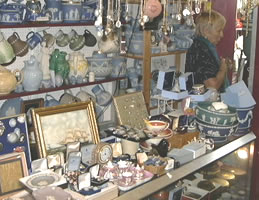 Antique shop, Portobello Road |
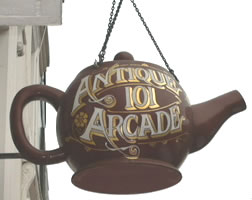 Antique Arcade signboard |
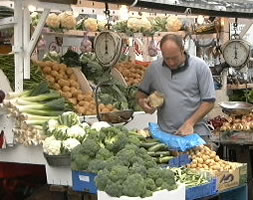 Vegetable stall, Portobello Road |
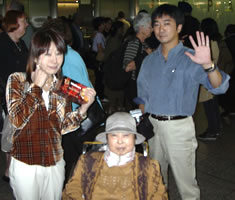 Leaving Heathrow Airport |
After breakfast, we checked out of the hotel and Akemi bought a porcelain doll from the hotel shop which reminded her of My Fair Lady. The doorman called a taxi for us: it was important to state that there were four of us and that we were carrying a lot of bags. Luckily the roads were not busy, so it only took about 30 minutes to get to Heathrow Terminal 3. The Virgin Atlantic check-in desk was in area A. Because Akemi had a first class ticket, they could use the Fast Track check-in counter instead of the normal one. At 1.00pm the flight left Heathrow, arriving in Narita at 9am (Japanese time) on Monday morning. |
|
|
|